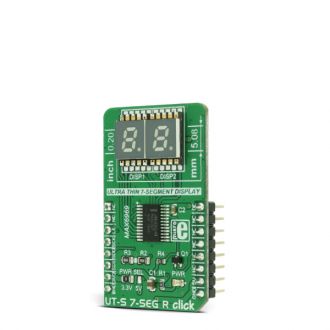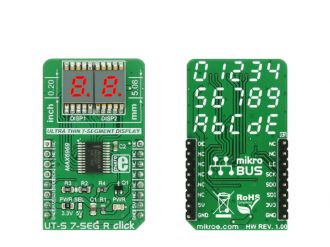
We strongly encourage users to use Package manager for sharing their code on Libstock website, because it boosts your efficiency and leaves the end user with no room for error. [more info]

Rating:
Author: MIKROE
Last Updated: 2018-01-21
Package Version: 1.0.0.0
mikroSDK Library: 1.0.0.0
Category: LED segment
Downloaded: 6212 times
Not followed.
License: MIT license
UT-S 7 SEG R click uses two SMD ultra-thin DSM7UA 7-SEG LED displays, made with the patented technology that delivers thickness of only 2.1 mm. These displays are driven by the MAX6969, a constant current LED integrated driver from Maxim Integrated, which uses the SPI serial interface for communication.
Do you want to subscribe in order to receive notifications regarding "UT-S 7 SEG R click" changes.
Do you want to unsubscribe in order to stop receiving notifications regarding "UT-S 7 SEG R click" changes.
Do you want to report abuse regarding "UT-S 7 SEG R click".


Library Description
The library covers all the necessary functions for UT-S 7SEG R click control.
Key functions
uts7segr_writeData - Generic write function
uts7segr_writeNumDec - Writes decimal number
uts7segr_writeNumHex - Writes hexadecimal number
Examples Description
The demo application is composed of three sections:
NOTE: Brightness can be adjusted using the MCUs PWM module. In that case, GPIO setup for PWM pin is not necessary.
void applicationTask()
{
uts7segr_writeData( _UTS7SEGR_MINUS, 0xFF );
counter = 0;
while (counter < 3)
{
uts7segr_lightCtl( 0 );
Delay_ms( 200 );
uts7segr_lightCtl( 1 );
Delay_ms( 300 );
counter++;
}
counter = 0;
while (counter < 100)
{
uts7segr_writeNumDec( counter );
Delay_ms(100);
counter++;
}
counter = 0;
while (counter < 0xFF)
{
uts7segr_writeNumHex( counter );
Delay_ms(100);
counter++;
}
counter = 0;
while (counter < 100)
{
uts7segr_writeNumDot( counter, _UTS7SEGR_DOT_L );
Delay_ms(100);
counter++;
}
}
Additional notes and information
Depending on the development board you are using, you may need USB UART click, USB UART 2 click or RS232 click to connect to your PC, for development systems with no UART to USB interface available on the board. The terminal available in all MikroElektronika compilers, or any other terminal application of your choice, can be used to read the message.